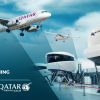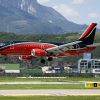 The beginning of the year was marked by another round of troubles for Boeing, once again highlighting the ongoing challenge of replacing the current 737NGs with MAX-generation narrowbodies. The prolonged and repeatedly postponed fleet renewals have resulted in more NGs remaining in service than most operators had planned, and less parts available in the aftermarket for them.
The beginning of the year was marked by another round of troubles for Boeing, once again highlighting the ongoing challenge of replacing the current 737NGs with MAX-generation narrowbodies. The prolonged and repeatedly postponed fleet renewals have resulted in more NGs remaining in service than most operators had planned, and less parts available in the aftermarket for them.
While awaiting the arrival of various 737 MAX derivatives, airlines are still flying 737NGs they have still must take care of the maintenance of these aging workhorses, some of which are already entering their third decade of operation. Consequently, in January, we experienced a surge in requests for various components of such planes. For instance, Integrated Drive Generators, specific to NGs, have become more desirable to obtain than before.
From the statistics, related to most searched aircraft parts which our marketplace has gathered during the first month of the year, another trend is apparent. The January saw a huge spurge in the specific, safety-related commercial aircraft components – from lens for the aircraft lights to fire blankets. There was a great surge in requests for battery operated underwater acoustic pulse generator, also known as cockpit voice recorder beacon, which is designated to assist in location of the device in the event of crash landing in water. Yet, supply of these parts is quite abundant, so the demand was generally satisfied and desired parts procured relatively fast and easy.
So, it is obvious that the aviation sector is currently trying to show the best it can in a delicate dance between innovation and legacy. While newer, more efficient models like the Boeing 737 MAX promise advancements, replacing aging fleets like the 737NG proves surprisingly complex. This year's first quarter painted a clear picture: Boeing faced renewed challenges, and airlines grappled with a scarcity of aftermarket parts for their trusty NG workhorses.
This scarcity stems from a prolonged and repeatedly postponed fleet renewal. More NGs remain in service than originally planned, leaving them reliant on a dwindling pool of parts. January saw a surge in demand for NG-specific components, as well as for these used in both NG and other airliners.
If the sector wants to stay competitive while the global aviation navigates these turbulent waters, most of the successful industry players already know the answer – or a few, as there already are some emerging trends and potential solutions, such as exploring alternative sourcing. Certified repair stations and parts exchange programs offer valuable alternatives, particularly for less readily available components. Online procurement platforms can further connect airlines, suppliers, and repair stations, facilitating communication and access to needed parts.4
Also, do not forget about modern technologies, which are consistently gaining more and more applicability within the market and beyond. For example, 3D printing technologies hold promise for on-demand production of spare parts, particularly for less complex or out-of-production components. Also known as additive manufacturing, this technology offers exciting possibilities for the future.
Of course, it's important to remember the difference between "desirable" and "hard-to-find" parts. While components like Integrated Drive Generators may be in high demand due to the large NG fleet, their actual availability might differ from parts truly difficult to source.
A cooperative strategy including manufacturers, suppliers, airlines, and regulatory agencies is required by the aviation sector to resolve this crisis. Investing in technology and improving communication are essential for identifying and mitigating early disruptions. Notwithstanding the difficulties, the aviation sector is committed to ensuring the efficient and safe operation of aircraft in the years to come.
Learn more: Locatory-Market-Overview-Jan-2024-v4.pdf





